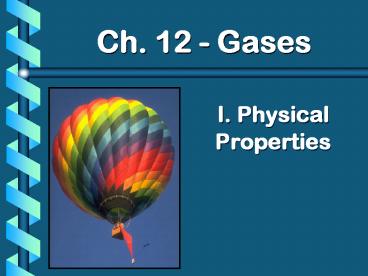I. Physical Properties - PowerPoint PPT Presentation
1 / 17
Title:
I. Physical Properties
Description:
Title: PPT: GAS LAWS Author: Robert E. Johannesson Last modified by: Jeanne Mason Created Date: 2/27/2000 8:14:20 PM Document presentation format – PowerPoint PPT presentation
Number of Views:37
Avg rating:3.0/5.0
Title: I. Physical Properties
1
I. Physical Properties
- Ch. 12 - Gases
2
A. Kinetic Molecular Theory
- Particles in an ideal gas
- have no volume.
- have elastic collisions.
- are in constant, random, straight-line motion.
- dont attract or repel each other.
- have an avg. KE directly related to Kelvin
temperature.
3
C. Characteristics of Gases
- Gases can be compressed.
- no volume lots of empty space
- Gases undergo diffusion effusion.
- random motion
4
E. Pressure
- Barometer
- measures atmospheric pressure
5
E. Pressure
- Manometer
- measures contained gas pressure
6
II. The Gas LawsBOYLESCHARLESGAY-LUSSAC
- Gases
7
A. Boyles Law
- The pressure and volume of a gas are inversely
related - at constant mass temp
P1V1 P2V2
8
B. Charles Law
- The volume and absolute temperature (K) of a gas
are directly related - at constant mass pressure
V1 V2 T1 T2
9
C. Gay-Lussacs Law
- The pressure and absolute temperature (K) of a
gas are directly related - at constant mass volume
P1 P2 T1 T2
10
D. Combined Gas Law
P T
V T
PV T
k
PV
P1V1T2 P2V2T1
11
E. Gas Law Problems
- A gas occupies 473 cm3 at 36C. Find its volume
at 94C.
CHARLES LAW
GIVEN V1 473 cm3 T1 36C 309K V2 ? T2
94C 367K
WORK P1V1T2 P2V2T1
T?
V?
(473 cm3)(367 K)V2(309 K) V2 562 cm3
12
E. Gas Law Problems
- A gas occupies 100. mL at 150. kPa. Find its
volume at 200. kPa.
BOYLES LAW
GIVEN V1 100. mL P1 150. kPa V2 ? P2
200. kPa
WORK P1V1T2 P2V2T1
P?
V?
(150.kPa)(100.mL)(200.kPa)V2 V2 75.0 mL
13
E. Gas Law Problems
- A gas occupies 7.84 cm3 at 71.8 kPa 25C. Find
its volume at STP.
COMBINED GAS LAW
GIVEN V1 7.84 cm3 P1 71.8 kPa T1 25C
298 K V2 ? P2 101.325 kPa T2 273 K
WORK P1V1T2 P2V2T1 (71.8 kPa)(7.84 cm3)(273
K) (101.325 kPa) V2 (298 K) V2 5.09 cm3
P? T?
V?
14
E. Gas Law Problems
- A gas pressure is 765 torr at 23C. At what
temperature will the pressure be 560. torr?
GAY-LUSSACS LAW
GIVEN P1 765 torr T1 23C 296K P2 560.
torr T2 ?
WORK P1V1T2 P2V2T1
P?
T?
(765 torr)T2 (560. torr)(309K) T2 226 K
-47C
15
A. Daltons Law
- A gas is collected over water at a temp of 35.0C
when the barometric pressure is 742.0 torr. What
is the partial pressure of the dry gas?
The total pressure in the collection bottle is
equal to barometric pressure and is a mixture of
the gas and water vapor.
DALTONS LAW
GIVEN Pgas ? Ptotal 742.0 torr PH2O 42.2
torr
WORK Ptotal Pgas PH2O 742.0 torr PH2
42.2 torr Pgas 699.8 torr
Look up water-vapor pressure on p.899 for 35.0C.
Sig Figs Round to least number of decimal places.
16
B. Ideal Gas Law
PVnRT
UNIVERSAL GAS CONSTANT R0.0821 L?atm/mol?K
17
B. Ideal Gas Law
- Calculate the pressure in atmospheres of 0.412
mol of He at 16C occupying 3.25 L.
IDEAL GAS LAW
GIVEN P ? atm n 0.412 mol T 16C 289 K V
3.25 L R 0.0821L?atm/mol?K
WORK PV nRT P(3.25)(0.412)(0.0821)(289)
L mol L?atm/mol?K K P 3.01
atm































